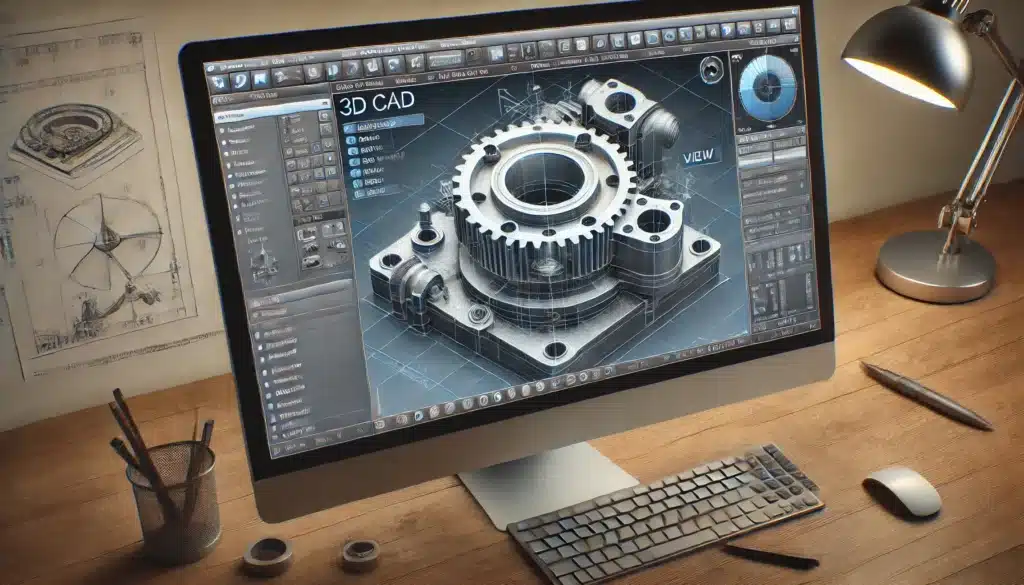CAD หรือ Computer-Aided Design เป็นกระบวนการที่ใช้คอมพิวเตอร์ช่วยในการออกแบบและสร้างแบบจำลองทางวิศวกรรมและสถาปัตยกรรม CAD ถูกนำมาใช้ในหลายสาขาวิชา เช่น วิศวกรรม สถาปัตยกรรม การออกแบบผลิตภัณฑ์ และอุตสาหกรรมต่าง ๆ เพื่อสร้างแบบจำลองที่แม่นยำและมีประสิทธิภาพมากกว่าการออกแบบด้วยมือ
Table of Contents
พื้นฐานของ CADThe Basics of CAD

CAD is a tool that allows users to create and modify 2D (two-dimensional) and 3D (three-dimensional) models with precision and speed. CAD programs typically offer a wide range of tools for creating outlines, surfaces, boundaries, and other elements necessary for building a complete model.
For example, in product design, engineers can use CAD to create 3D models of various components and quickly check how they fit together. Additionally, CAD aids in analyzing the strength, motion, and mechanical behavior of the models.
Benefits of Using CAD

High Accuracy and Detail: CAD allows designs to be created with high precision, which is crucial in tasks requiring detailed work, such as designing machinery or medical devices.
Speed and Efficiency: CAD reduces the time required to design and model, enabling quick improvements and testing of new ideas.
Virtual Analysis and Testing: CAD often includes tools for virtual analysis and testing of models, such as strength testing and motion simulation, which help reduce production risks and enhance product efficiency.
Applications of CAD in Various Industries

Engineering: In the design of machinery and industrial parts, CAD is an indispensable tool for creating complex and precise 3D models.
Architecture: Architects use CAD to create models of buildings and structures, providing a clear overview of projects before construction.
Product Design: Designers use CAD to develop new products, from prototyping to actual production, ensuring reliability and allowing for continuous improvement.
Conclusion: The Importance of CAD in the Modern Era
CAD is an essential tool in today’s world that enables design and modeling to be done more efficiently and accurately. Whether you are an engineer, architect, or product designer, using CAD helps you deliver high-quality work that meets market demands.
Understanding and correctly using CAD not only improves work efficiency but also opens up new opportunities for innovation and project development in the future.
What is CAD?
CAD or Computer-Aided Design is a process that uses computers to assist in the design and creation of models for engineering and architecture. CAD is utilized across various fields such as engineering, architecture, product design, and other industries to create models that are more accurate and efficient than hand-drawn designs.
The Basics of CAD
CAD is a tool that allows users to create and modify 2D (two-dimensional) and 3D (three-dimensional) models with precision and speed. CAD programs typically offer a wide range of tools for creating outlines, surfaces, boundaries, and other elements necessary for building a complete model.
For example, in product design, engineers can use CAD to create 3D models of various components and quickly check how they fit together. Additionally, CAD aids in analyzing the strength, motion, and mechanical behavior of the models.
Benefits of Using CAD
- High Accuracy and Detail: CAD allows designs to be created with high precision, which is crucial in tasks requiring detailed work, such as designing machinery or medical devices.
- Speed and Efficiency: CAD reduces the time required to design and model, enabling quick improvements and testing of new ideas.
- Virtual Analysis and Testing: CAD often includes tools for virtual analysis and testing of models, such as strength testing and motion simulation, which help reduce production risks and enhance product efficiency.
Applications of CAD in Various Industries
- Engineering: In the design of machinery and industrial parts, CAD is an indispensable tool for creating complex and precise 3D models.
- Architecture: Architects use CAD to create models of buildings and structures, providing a clear overview of projects before construction.
- Product Design: Designers use CAD to develop new products, from prototyping to actual production, ensuring reliability and allowing for continuous improvement.
Conclusion: The Importance of CAD in the Modern Era
CAD is an essential tool in today’s world that enables design and modeling to be done more efficiently and accurately. Whether you are an engineer, architect, or product designer, using CAD helps you deliver high-quality work that meets market demands.
Understanding and correctly using CAD not only improves work efficiency but also opens up new opportunities for innovation and project development in the future.
References
- Fisher, R. (2012). The CAD Guide: A Comprehensive Overview of Computer-Aided Design. McGraw-Hill Education.
- Zeid, I. (2005). Mastering CAD/CAM. McGraw-Hill Education.
- Harrington, S. (2000). Computer Graphics: A Programming Approach. McGraw-Hill Education.

